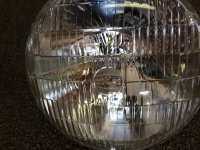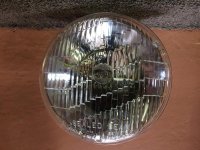Rob Glasgow
Jedi Knight
Offline
A few years ago I purchased 2 used Lucas Headlights to use on my BT7. Although I know there are better, brighter and safer alternatives than the original bulbs, I just like the look of the Lucas logo up front. One of the bulbs I purchased was a match to an original in pattern and marking. The horizontal lens lines were straight across the surface and the lens had a large "2" at the top. The other bulb was different. The lens lines "stepped up" across the face of the bulb and instead of a "2" at the top, it had an arrow pointing right. There were some other numbers on the front. JC 10170 S13 and 73. Anyone know if this might have been an English or European version? I just purchased another 'standard' Lucas bulb to give me two matching bulbs, but was just wondering if anyone has any ideas. This is certainly digging deep in the weeds when it comes to important issues of our time......
The bulb on the left is the 'standard' and the one one the right has the "stepped" pattern.
The bulb on the left is the 'standard' and the one one the right has the "stepped" pattern.

 Hi Guest!
Hi Guest!

 smilie in place of the real @
smilie in place of the real @
 Pretty Please - add it to our Events forum(s) and add to the calendar! >>
Pretty Please - add it to our Events forum(s) and add to the calendar! >> 





